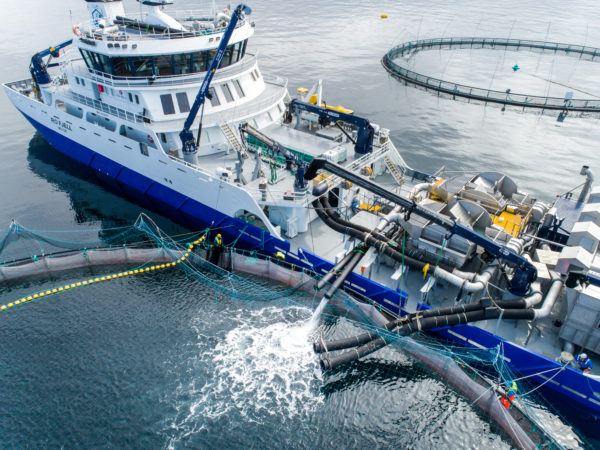Last Updated on January 21, 2021 by PALFINGER
Having recently stepped into 2021, leaving behind a year full of challenges, we consider it a good time to purposely look back to a piece of good news and ahead to a promising future. Ro Vision, the world’s first hybrid-powered live fish carrier, has been awarded the title “Ship of the Year 2020.” This prestigious title is a recognition to which many shipbuilders aspire. It is a title that honors their ambitions to reduce marine pollution and find new, eco-friendly solutions for the shipping industry. For us, Ro Vision’s success is a typical case of “one’s joy is the other’s joy.” In fact, five PALFINGER marine cranes adorn the deck of this state-of-the-art live fish carrier.
“We feel honored that we were part of this exciting project,” says Bernd Huemer, Area Sales Manager for PALFINGER’s marine business. “In sum, we supplied four telescopic boom cranes and one foldable knuckle boom crane. As always, our long-term dealer, Bergen Hydraulic, did a wonderful job here,” Bernd points out.
“Ro Vision is a forward-thinking project, setting an example for ecological awareness. What’s more, it goes in line with our own sustainability values.”
Bernd Huemer, Area Sales Manager EMEA for PALFINGER’s marine business.
Ro Vision is fitted with three 1,300 kW diesel generators instead of four. The fourth was replaced by a 600 kW battery pack. Ultimately, the vessel produces fewer CO2 emissions. Hence, it may inspire future shipbuilding projects and be used as a “template” to rebuild existing vessels based on its standard. Being the very first hybrid-powered live fish carrier makes Ro Vision a pioneer of sustainable solutions in the aquaculture industry.
Competitive cranes for the fish-farming business
In his 15-year career at PALFINGER, Bernd has had quite some time to build up his expertise in the marine business, which, among others, includes the aquaculture market. “Being at sea, you never know what you’re going to get – be it the weather or the sea’s conditions. Therefore, safe, efficient, and reliable deck equipment is immensely important,” emphasizes the sales expert. He continues: “First and foremost, our marine cranes must be fit for long and daily operation. They need to be lightweight, strong, compact, and easy to handle. Finally, they need to be durable and withstand the toughest conditions – no half-measures. This is what our clients in the fish-farming industry opt for, and this is what we deliver. After all, we have a great responsibility on our shoulders, which we intend to bear with respect.”

PALFINGER cranes on deck of Ro Fjell
Not only are these requirements met by the product itself, but also by the global PALFINGER service network, which ensures fast local support and high availability of spare parts. “It is in fact the mix of PALFINGER-owned service hubs and our cooperation with partners around the world that guarantees quick and reliable on-site support,” Bernd adds.
Annual balance 2020: full order book
It comes as no surprise, then, that world-leading live fish carrier owners are among PALFINGER’s customers. In 2020 alone, Bernd and his team landed seven major deals. In addition to several projects in Norway, contracts have been secured in Brazil and Spain. The latter one is being handled in cooperation with PALFINGER’s Ibérica office. Rubén Alonso Corcuera, the local sales representative, provides the details: “We are going to supply three telescopic boom cranes to a live fish carrier owned by a Norwegian company. These proven live fish carrier solutions will come with two winch setups and increased outreach. Additionally, our customer chose our well-established PK18500 MC foldable knuckle boom crane. Finally, we will provide a central remote-control system.”
Three further PK65002 foldable knuckle boom cranes with integrated hydraulic power units will be delivered to a live fish carrier built in Brazil for the Chilean market. For this project, PALFINGER’s Sales Manager Ramiro de Queiroz is offering local support.
PALFINGER gained a foothold in the aquaculture industry almost 30 years ago – as soon as the company entered the marine market, to be exact. That was about the time when PALFINGER partnered up with Bergen Hydraulic, Norway’s leading supplier of hydraulic cranes for aquaculture and further segments. “This partnership basically opened the door for us to the Norwegian fish-farming industry, which eventually became our strongest market,” says Bernd. “Other growing market shares include Chile, Canada, UK, the Faroe Islands, Croatia, Tasmania, and Korea.”
Promising future for ‘fish farmers’
While we’re wondering what the future holds for the fish-farming industry, Christian Hoff, General Manager of Bergen Hydraulic, has a pretty good idea: “The fish-farming industry is a stable business. Even the coronavirus pandemic hasn’t left a mark on it. Quite the opposite – the business continues to grow,” he says. “This trend results from the ever-growing world population. Along with that, the global demand for seafood is increasing,” Christian adds. The fish-farming expert’s argument is underlined by the Food and Agriculture Organization’s (FAO) most recent statistics, showing that aquaculture has been the main driver of the increase in fisheries and aquaculture production in the last three decades.
What does that mean for PALFINGER? Bernd explains: “We may expand and enter new international markets. Furthermore, we expect not only a rising number of facilities and vessels, but also an increase in their size – a trend that has been going on for years. This, again, is reflected in the size of our marine cranes.” Christian and Bernd also mention alternative fish-farming solutions that are currently being explored in response to the rising demand for fish. Both PALFINGER and Bergen Hydraulic are expecting to play an important role here in the future.
Copyright featured image: © Rostein

2 comments on “Fish-farming for the future”